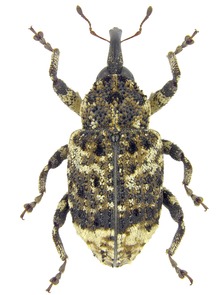Cryptorhynchinae

| Cryptorhynchinae | |
|---|---|

| |
| Cryptorhynchus lapathi | |
| Scientific classification | |
| Domain: | Eukaryota |
| Kingdom: | Animalia |
| Phylum: | Arthropoda |
| Class: | Insecta |
| Order: | Coleoptera |
| Family: | Curculionidae |
| Subfamily: | Cryptorhynchinae Schönherr, 1825 |

The Cryptorhynchinae is a large subfamily of weevils (Curculionidae), with some 6000 species. They are found in most zoogeographic regions although they are most diverse in the Neotropics, Australia and Oceania.
They are distinguished by having their rostrum (snout) backwardly directed between their fore coxae in repose, and fitting within a protective channel that usually ends in a cup-like structure on the mesoventrite (ventral mid thoracic segment).[1] The ends of the tibiae also bear an uncus (small hook-like extensions), a character they share with many other groups of Curculionidae that use woody plants for oviposition. They are merged into the Molytinae in some treatments,[2] but a recent molecular study shows that Cryptorhynchinae sensu stricto are monophyletic and best kept as an independent subfamily.[3]
Some species of Cryptorhynchinae are considered agricultural pests, such as the mango seed weevil Sternochetus mangiferae, but the great majority of species live in primary forests, often on deadwood and are threatened by habitat loss. In Europe, the flightless genus Acalles is most diverse, and restricted to woodlands of long-lasting habitat continuity[4]
Genera
These 42 genera (and likely others) belong to the subfamily Cryptorhynchinae:
- Acalles Schönherr, 1825 i c g b
- Anaballus Blanchard, 1849 c g
- Apteromechus Faust, 1896 i c g b
- Asytesta Pascoe, 1865 c g
- Blepiarda Pascoe, 1865 c g
- Calles Kissinger, 1964 i c g b
- Canistes Casey, 1892 i c g b
- Cedilaus Lea, 1912 c g
- Cnemidoprion Marshall, 1933 c g b
- Cophes Champion, 1905 i c g b
- Cryptorhynchus Illiger, 1807 i c g b
- Didymus Kuschel, 1982 c g
- Episcirrus Kuschel, 1958 i c g b
- Eubulus Kirsch, 1870 i c g b
- Eurhoptus LeConte, 1876 i c g b
- Euscepes Schönherr, 1844 i c g b
- Eutinobothris b
- Faustinus Berg, 1898 i c g b
- Gasterocercus de Laporte Castelnau La Ferté-Sénectère & Brullé, 1828 c g
- Gerstaeckeria Champion, 1905 i c g b (cactus weevils)
- Hohonus Kissinger, 1964 i c g b
- Lembodes Schönherr, 1844 i c g b
- Liometophilus Fall, 1912 i c g b
- Maemactes Schönherr, 1837 i c g b
- Neoulosomus O'Brien & Wibmer, 1982 i c g b
- Paracamptus Casey, 1895 c g b
- Peracalles Kissinger, 1964 i c g b
- Phyrdenus LeConte, 1876 i c g b
- Poropterus Schönherr, 1844 c g
- Pseudoacalles Blatchley, 1916 i c g b
- Pseudomopsis Champion, 1905 i c g b
- Pseudomus Schönherr, 1837 i c g b
- Rhynchodes White, 1846 c g
- Rhynchus Kissinger, 1964 i c g b
- Sternochetus Pierce, 1917 i c g b
- Sudus Kissinger, 1964 i c g b
- Tepperia Kirby, 1910 g
- Trigonopterus Fauvel, 1862 c g
- Troezon Champion, 1906 c g b
- Tyloderma Say, 1831 i c g b
- Zascelis LeConte, 1876 i c g b
- Zygara Pascoe, 1885 c g
Data sources: i = ITIS,[5] c = Catalogue of Life,[6] g = GBIF,[7] b = Bugguide.net[8]
References
- ^ Lyal, C.H.C. (1993) Coleoptera: Cryptorhynchinae. Fauna of New Zealand 29. Lincoln, Canterbury. 1–308.
- ^ Lyal, C.H.C. (2014) 3.7.7 Molytinae Schoenherr, 1823. In: Leschen R.A.B. & Beutel, R.G. (Eds) Handbook of Zoology, Coleoptera, Beetles Volume 3: Morphology and Systematics (Phytophaga). DeGruyter, Berlin, 529–570.
- ^ Riedel, A., Tänzler, R., Pons, J., Suhardjono, Y. R., & Balke, M. (2016). Large-scale molecular phylogeny of Cryptorhynchinae (Coleoptera, Curculionidae ) from multiple genes suggests American origin and later Australian radiation. Systematic Entomology. http://doi.org/10.1111/syen.12170
- ^ Buse, J., (2012) “Ghosts of the past”: flightless saproxylic weevils (Coleoptera: Curculionidae) are relict species in ancient woodlands. Journal of Insect Conservation 16 (1), 93–102.
- ^ "ITIS, Integrated Taxonomic Information System". Retrieved 2018-04-25.
- ^ "Catalogue of Life". Retrieved 2018-04-25.
- ^ "GBIF". Retrieved 2018-04-25.
- ^ "Cryptorhynchinae Subfamily Information". BugGuide.net. Retrieved 2018-04-25.
- ^ Stüben, Peter E. (1 February 2018). The Cryptorhynchinae of the Western Palearctic / Die Cryptorhynchinae der Westpaläarktis. Germany, Mönchengladbach: Curculio Institute. p. 518. ISBN 978-3-00-058038-3.
